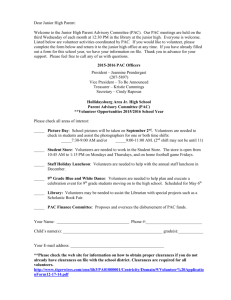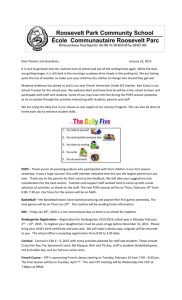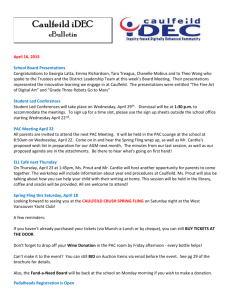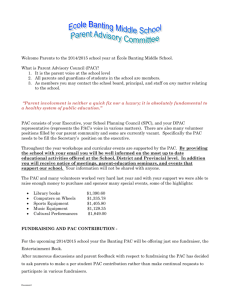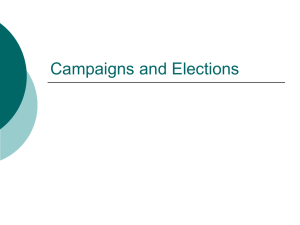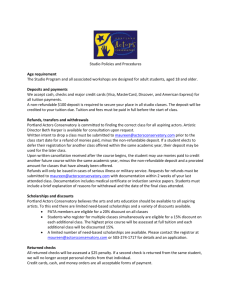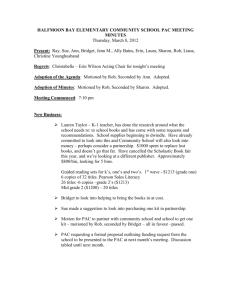Preservation & conservation research paper
advertisement
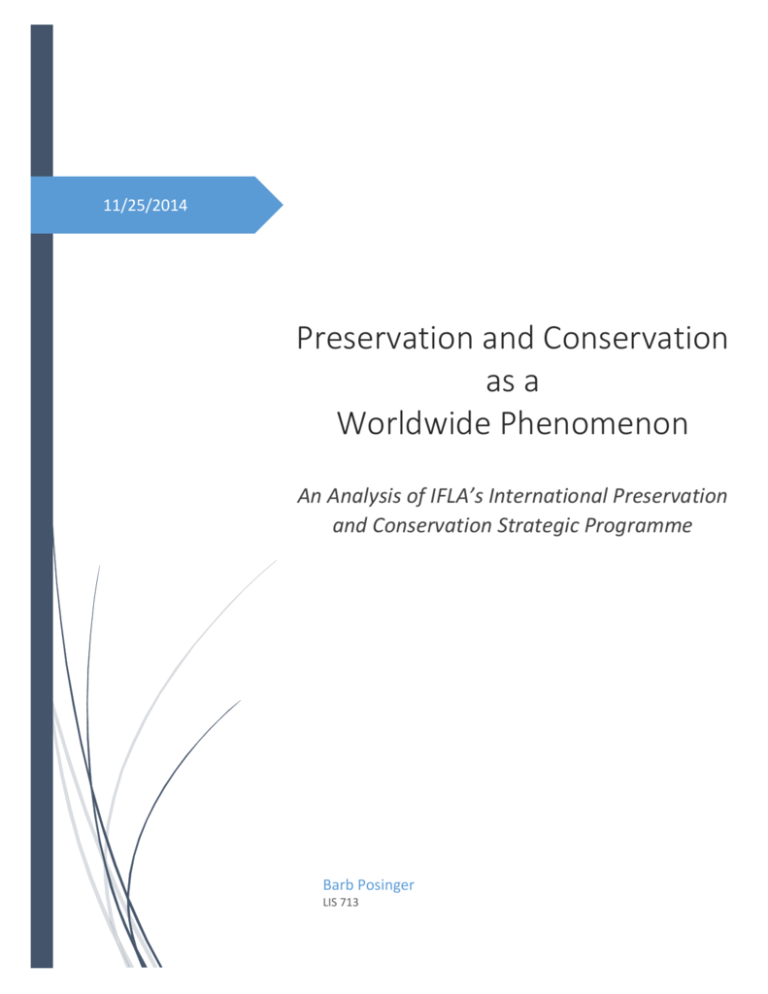
11/25/2014 Preservation and Conservation as a Worldwide Phenomenon An Analysis of IFLA’s International Preservation and Conservation Strategic Programme Barb Posinger LIS 713 Page |1 The idea of preserving and conserving library and archive materials is one that most professionals in the library field graciously advocate. However, when put into action, preservation and conservation practices tend to suffer from a serious lack of proper support from libraries. The preservation and conservation world necessitates patience, time, and serious efforts in order to accomplish singular tasks. These tasks do not exemplify instantaneous mass market production approaches that are so common and expected in this day and age. These tasks also dramatically affect budget availability, time restraints, and the number of paid positions available for professional conservators. From a single library’s perspective, these issues may seem as if they can be sufficiently managed with dedicated work. However, when analyzed from a worldwide perspective, the intensity of these issues exponentially increase. The level of concern for the preservation and conservation of ancient materials/artifacts fluctuates from country to country, leaving no certainty regarding the level of care and expertise shown to these fragile, treasured materials. Without some form of collaborative association whose sole purpose is to provide fruitful endeavors for preservation and conservation practices, the materials that represent humanity’s history will degrade and will eventually be lost forever. Luckily, such a program does exist: The Preservation and Conversation Strategic Program (PAC) that was created by the International Federation of Library Associations (IFLA). According to the PAC section on the IFLA website, the PAC strategic program intends to “focus on issues of preservation and initiate worldwide cooperation for the preservation of library materials.” This program creates the opportunity for advancing worldwide acknowledgement and understanding of preservation/conservation issues while simultaneously providing a foundation for worldwide collaboration. Within this analysis, readers will find a comprehensive exploration of many facets within the online representation of the PAC program. It examines the origins of the PAC program in order to understand the foundational principles on which the program was founded. It also inspects the efforts of the PAC program from its initial creation through its current developments in order to determine PAC’s overall influence on the international preservation/conservation community. Lastly, this analysis will evaluate the successes of this program in order to measure the extent on which PAC has influenced local and international perceptions. Page |2 By understanding the history, efforts, and successes of the PAC program, professionals and inspired civilians will be able to comprehend the ubiquitous productivity and measurable impact the PAC program has instilled within worldwide preservation and conservation practices. All information and resources presented throughout this analysis were collected from IFLA’s PAC webpage located at http://www.ifla.org/pac. History of the Preservation and Conservation Strategic Programme (PAC) PAC was initially created in 1984 during an annual IFLA conference held in Nairobi. The official launching of the program would occur two years later during the Conference on the Preservation of Library Materials held in Vienna by IFLA and the United Nations Educational, Scientific, and Cultural Organization; otherwise known as UNESCO. The foundational objective of PAC is “to ensure that library and archive materials, published and unpublished, in all formats, will be preserved in accessible form for as long as possible.” PAC outlined three significant principles that would ultimately aid in the overall comprehension, understanding, and importance of this mission: first, “preservation is essential to the survival and development of culture and scholarship;” second, “international cooperation is a key principle;” third, “each country must accept responsibility for the preservation of its own publications.” During creation, PAC planned to incorporate various activities that would potentially aid in the program’s success. Examples of such activities included raising awareness, publishing universally available print and online preservation literature, fund raising, and training courses for employees. The initial efforts of the PAC program attempted to create and/or increase a worldwide understanding of the importance of preserving and conserving humanity’s past while simultaneously providing an organized foundation to do so. They proved the value of this action through their highlighted principles. For example, the first principle states that preservation is directly associated with the development of culture and scholarship. Through this concept, PAC exemplifies the idea that the past has directly influenced our present. It reflects a relationship of the human race through time. With greater understanding of our past, we can better understand today’s cultures. The second principle states that international cooperation is key. Through this idea, PAC is claiming that countless facets of humanity’s past have far greater potential to be lost Page |3 or endangered without international cooperation. The most concerning model of this fearsome potential is the destruction of war. For example, irreplaceable Jewish art and novels during were irrevocably lost during World War II. With expansive international cooperation, these priceless artifacts have a stronger defense against extinction. The last principle states that each country is responsible for the preservation of its own materials. This principle eradicates any issue reflecting unwanted foreign involvement with treasured pieces of autonomous cultural history. It also provides an element of independent power from this collaborative unit which decreases levels of hostility and disagreement. By understanding the overall significance of PAC, the world is offered an opportunity for humanity to come together to save, restore and sustain rare materials from our past. Since PAC’s initial creation, the program has grown exponentially. There are PAC centers located in national libraries on every inhabited continent. Countries with existing PAC centers include the United States, Venezuela, Trinidad and Tobago, Brazil, Chile, Russia, Republic of Kazakhstan, China, Korea, Canberra (Australia Capitol), Bénin (Africa) and Pretoria (South Africa). Efforts are currently in the works to create more expansive PAC centers in Western Europe, North Africa and the Middle East. PAC also advocates for cooperative preservation/conservation partnerships within inside (IFLA) and outside establishments. Over time, a myriad of associations have partnered with PAC. Examples of these associations include the Ecole du Patrimoine Africain (EPA), the International Center for the Study of the Preservation and Restoration of Cultural Property (ICCROM), and the Asociación de Bibliotecas Nacionales de Iberoamérica (ABINIA). The collaborations between PAC and these independent organizations vary according to the location, problems, and missions that reflect each specific institution. The dramatic growth that this program has accomplished is proof that PAC has become a substantial and encouraged element within the conservation community. It has shown that people all over the world care about the safety of their cultural heritage, and will set aside differences in order accomplish a common goal. Efforts and Successes of the PAC Program The efforts of the PAC program are sufficiently represented in various formats. The program’s webpage provides public access to strategic plans, annual reports, publications, Page |4 general news, and conferences/events that all collaborate in order to epitomize PAC. When these sections are analyzed as a whole, PAC’s wide-ranging successes make themselves apparent. Strategic Plans IFLA’s PAC program initiated strategic plans during the years 2004-2005, and 20062007. The official title being, “The Core Activity on Preservation and Conservation: Strategic Plan,” these documents were designed to reiterate the PAC program’s mission and provide an official list of innovative goals for the program to accomplish in the upcoming years. Within the mission, the reports defined three major strategies PAC would use in order to accomplish its goals. These strategies included training, production and dissemination of information, and research and participation in the development of new standards. By following these strategies, PAC would potentially be able to achieve its preliminary goals in an organized, controlled and structured manner. Dictated within each strategic plan were five foundational goals that the PAC program would continuously seek to achieve. The first goal attempts to, “develop and reorganize the existing network of preservation professionals.” The second goal intends to, “raise awareness of preservation issues, train staff and technicians, produce and disseminate information, and encourage people to respect the documentary heritage.” The third goal aims to “assess needs in preservation through surveys and promote the development of national and international standards, guidelines and best practice in the field of preservation.” The fourth goal hopes to, “encourage scientific research on the causes of deterioration of library documents in all formats, including digital materials and promote reformatting as a preservation option.” The fifth goal ambition is to, “develop a policy of coordination activities with institutions, with national or international organizations, with NGOs as well as with information professionals interested in the preservation of the documentary heritage.” Each individual goal was paired with various action plans designed to achieve each goal. The actions that were unmet in the 2004-2005 strategic plan carried over to the 2006-2007 plan. Closer analysis has proven that many of the PAC action plans were quite successful. For example, one of PAC’s action plans for the first goal was to create regional centers in Latin America/Caribbean, Africa, and Asia. As stated above, PAC has regional centers situated in the national libraries located in each of these regions in present time, thus proving the success of this Page |5 particular goal. Another successful action plan in regards to the second goal was to publish both a newsletter called International Preservation News, and a collection of documents under the label International Preservation Issues. Both publications are presently endorsed and will be discussed more thoroughly later. Various expansions of PAC have been initiated over the thirty years surrounding the program’s existence including annual conferences, events, and various publications that all relate to the goals representing scientific research, policy building, and needs assessments. PAC’s strategic plans were profound, organized, and clearly defined. The program has accomplished many endeavors that were in direct correlation to the action plans laid out in the strategic plan documents. However, the fact that only two official strategic plans were available stresses a severe lack of organized structure and commitment from program leaders. Even if specific actions were not met in the calculated time-frame, strategic plans should still be published and made available every other year. Nearly ten years have passed since the last strategic plan was publicly made available. Ten years without an updated strategic plan leaves uncertainty for the future. This obvious lack of coherent strategic guidelines may potentially lead the program into a spiraling downfall. It would not be long before the program extinguished itself. However, PAC has delivered a resourceful annual report that closely illustrates PAC activities in lieu of annual strategic plans. This report provides a lifeline to the program’s survival through documented activities, events, and reports. Annual Reports Pac’s annual reports began in the year 2000 and have consistently been published to the present day. The last official report was published this year documenting 2013’s undertakings. Over the years, the reports have become increasingly more involved, professional, and extensive which suggests a positive pattern regarding the growth and depth of PAC. For the sake of brevity, this paper will present a comparative analysis of the annual reports from years 2000, 2007, and 2014. These years were chosen in order to deliver a well-rounded account of the progression of the PAC program over the last 15 years. The annual report for the year 2000 is presented by a rather plain .pdf file embodied by a grand total of five pages. There is no title page; only an official heading directly before the main bulk of information. The report is not formatted very well, but the material is clear enough. The Page |6 information covers basic accomplishments, issues, publications, and updates that have occurred during the year 2000. Conference/meeting dates, locations, and objects were provided in graphic form that evidenced remarkably widespread international involvement. Myriad translations of various articles and publications were completed by partnering international libraries during this year. Considering that this was the first annual report produced by the PAC program readers should not criticize its brevity too harshly. Though the overall presentation of the report was arguably less than adequate, the volume of endeavors was actually quite impressive. The simple creation of this report paired with its expansive and clearly defined labor proved that the PAC program was beginning to make a significant, noticeable impact on the world during the year 2000. In the seven years since the initial annual report in 2000, the PAC program exponentially advanced. The annual report from 2007 dramatically outperformed the 2000 report in every possible way. The presentation was a far more professional .pdf file; complete with an appropriate title page, table of contents, clean structure, and much more detailed features. The total page count of the 2007 report is twenty-four pages, an exceptional advancement from 2000’s lackluster five pages. Similar information was provided throughout the entire report which advocates foundational consistency. However, the information in this report was far more detailed, organized, and capacious. Important PAC information (publications, conferences, activities and more) was directly translated into the languages representing the international regions involved with PAC. This action verified the considerable unity of international PAC regions. Other information concerning management members, cooperative efforts, and publications also drastically exceeded previously met standards. All in all, the intense evolution of PAC has erupted due to the exponential development and extreme support that this program has dutifully earned throughout this timeframe. The annual report for 2013 was upgraded from a single .pdf file to its own webpage. There was simply too much regionalized content to provide one .pdf file with the myriad of information collected and distributed by a single authoritative PAC member. Instead, the 2013 report provided multiple links to independent .pdf files representing regional activities for the year. Every .pdf file was separately submitted by each distinct PAC regional center. For 2013’s report, PAC submissions were provided by centers located in Chile, Brazil, US and Canada, Page |7 Oceania and Southeast Asia, Asia, and Southern Africa. The last update made to this report was as recent as November 3rd, 2014 which shows that this page is dependable for current information. Further investigation proved that each regional center’s activities were independently based in order to suit their region’s own specific needs; though, certain similarities were made apparent in terms of publications, training, and collaborative efforts. Unfortunately, the 2013 .pdf layouts were not consistent. Many of them were rather unorganized and not principally detailed. Particularly bothersome was the fact that official contact information was not made available on every .pdf. Though this information would be easy to find, it should still be made available on every official published document. Though there are many concerning issues and inconsistencies within these individual .pdf files, this is the first year this type of structure was used to represent an annual report. Year 2012’s report was still presented as a singular .pdf form that possessed an increased total of fifty-four pages. The growth shows that, every year, PAC activities were expanding. It became obvious that PAC efforts could not be adequately represented through a singular file. Therefore, a new structure was required. With 2013 as the trial year for the report’s new structure, mistakes were bound to happen. The following years will doubtlessly show more consistency and organization as the report structure becomes more commonplace. The collection of PAC annual reports are documented proof of the activities and advancements this program has accomplished over the years. International level associations are not easy to organize. Yet, PAC has produced a well-rounded approach of sufficient documentation and flexibility in relation to its excessive growth, regardless of a few inconsistencies. Overall, these informational annual reports are great indicators of the functionality and justification of this program. Publications As stated above, there are two primary publications related specifically to the PAC program: International Preservation News and International Preservation Issues. Other noteworthy digital PAC publications are a set of three guideline periodicals, all of which refer to issues presented in International Preservation Issues. Outside of PAC, IFLA provides its own journal that offers publications concerning all topics related to IFLA. This journal is linked to the PAC page. Page |8 The International Preservation News newsletter has been in publication since 1997 and is published three times yearly during the months of May, August, and December. This newsletter reports on “the preservation activities and events that support efforts to preserve materials in the world’s libraries and archives.” All issues reflect various themes and are freely available to the public through the PAC page on the IFLA website. Each issue is quite extensive, complete with preservation/conservation articles, archives, photos and more, provided by professionals from all over the world. The articles are published in English with summaries in Spanish and French. The International Preservation Issues newsletter is “a collection of studies, surveys, or basics on preservation issues to complement the publication of International Preservation News.” There are seven published newsletters in the IPI ranging from 1996-2006, each covering a specific issue during its time. The IPI newsletters are freely available to the public. Three IPI issues were constructed as guideline periodicals that resulted in unparalleled significance. These guidelines were arranged with their own conspicuous placement on the PAC page in order to provide easily accessible basic, crucial procedures to foundational conservation/preservation practices. The official guidelines are titled “IFLA Principles for the Care and Handling of Library Materials,” “IFLA Disaster Preparedness and Planning: A Brief Manual,” and “Care, Handling and Storage of Photographs.” These topics are too crucial to preservation practice to be overlooked in any way. Thus, PAC ensured the accessibility of these documents through publicly available .pdf downloads available in multiple languages. These guidelines reflect PAC’s mission by offering specific strategies to preliminary, yet complicated conservation work. Together, the International Preservation Issues and International Preservation News publications work together to incorporate and publicize every angle of the preservation/conservation community. They form an organized and accessible collection of professional publications that discuss preservation/conservation issues, solutions, and guidelines and display it in a comprehensive format that anyone can use. General News The PAC website offers a general news section that displays articles relating specifically to the program. Release dates for International Preservation News issues are always announced Page |9 in this section. Other articles relate to PAC meetings, conferences, and events. New articles are made available every few months, which portrays a regular enough cycle for this style of program. This section would be greatly improved if social media functions were made available to casual users and browsers. Currently, there is no social media connection to the PAC program. This should change in the future, for a functional and current social media site can gain a large community following bursting with support. Social media utilization would be a tremendously productive way to reach, educate, and interact with the general public about preservation/conservation practices. Conferences and Events Multiple PAC conferences and events are held annually in various international areas. The conference styles vary from open sessions to planned conferences with scheduled speakers and topics. Each conference represents a different, unique theme relating to preservation and conservation. A 2009-2013 list of past conferences, themes, events, and speakers is freely obtainable on the PAC webpage. Many articles, reports, and presentations from these conferences are also available for review through linked .pdf files. The accessibility of this information provides an opportunity for the public to educate themselves about recent concerns, breakthroughs and current events from a trustworthy, dependable source. The information itself acts as a catalyst for future advancements while simultaneously providing productive strategies for every aspect of preservation/conservation practices. Preparations for future conferences offer PAC members and other professional individuals the opportunity to submit paper proposals. After a process of editing and reviewing, these proposals may potentially be presented at the next conference. This opportunity is equal for anyone willing to broadcast his/her research in a formal, professional setting. All in all, the communal effort of the PAC program seems to be well-rounded, current, and appropriately paced. By ensuring that each conference is held in a different international location, PAC members can truly experience the heart of the program while simultaneously connecting with various cultures. This type of experience reduces cultural tensions and breaks cultural boundaries. It allows people of all ethnicities to come together in an accepting and P a g e | 10 understanding environment. As stated earlier, PAC is currently attempting to expand its regional centers even farther across the globe. This act aims to incorporate even more diverse cultural affiliations. PAC’s conferences/events efficaciously exemplify the overall mission of the PAC program by promoting worldwide cooperation for preservation and conservation practices. Conclusion It is not a simple task to create an international association based upon a topic that is often overlooked, such as preservation and conservation. IFLA knew that the creation of the Preservation and Conservation Strategic Programme would be a strenuous challenge. IFLA accepted it with serious commitment and profound earnestness anyway, regardless of the many difficulties the program was sure to face. Not without difficulty, PAC has slowly managed to gain international encouragement despite the lack of support this type of practice tends to locally suffer. PAC has evolved into the collaborative association the world lacked and desperately needed. The initial creators of the PAC program had the foresight to corroborate their missions, goals, and accomplishments within a series of documented strategic plans and annual reports. These documents represent the momentous value of the PAC program in many ways. The strategic plans lay out numerous goals that dramatically aid in specific PAC objectives. They were clear-cut, directive actions that propelled PAC forward into worldwide recognition. The annual reports documented every occurrence with which PAC was involved. The substantial growth of these reports over time proved an increase in support and justification for the PAC program. Without these documents, PAC’s true influence would have faded away in time, ironically similar to the way fate would have dealt with ancient, fragile library materials and archives if PAC had not been created. The purpose of PAC publications is to keep the community involved, educated, and aware of the program’s efforts. This aids them in their understanding of the fragility of humanity’s physical past while simultaneously providing solutions to save it. These publications constitute a great effort from collaborators to provide a comprehensive, one-stop source for PAC research on preservation and conservation. It combines work completed by PAC members from all over the world. It also offers copies in multiple languages which promotes worldwide P a g e | 11 consideration and comprehension. Over time, International Preservation News has developed into a substantially more professional and abundant resource by adapting to the consistent growth rate of the PAC program. Adaptation is a necessary skill that can be extremely difficult for associations to manage, but PAC has consistently proven to embrace this skill and morph it into a result even more productive than before. PAC further extends their outreach efforts through their general news section. It acts as a public platform for current PAC undertakings and updates. This effort keeps the public current with PAC ventures and offers a comfortable invitation for involvement. This effort instills extra, enduring value to the broad perception of preservation and conservation practice. The multiple PAC conferences/events have marked a designated faithfulness to the program. It acts as proof that PAC works all year round in order to ensure the stability and currency of its efforts. These conferences also secure cultural incorporation and contributions to the PAC program. It is a face-to-face educational gathering where all those involved with preservation/conservation practice can personally express themselves and build real relationships with other PAC advocates. The significance of connecting on a personal level should never be underestimated, and PAC clearly advocates the benefits this personal form of interaction can provide. Since 1984, the PAC program’s efforts have managed to reach across the globe and influentially educate, expand and collaborate with people who recognize the extreme value of saving humanity’s cultural heritage. It has become the world’s defense against the loss of irreplaceable materials. Over time, PAC will continue to inspire people from all over the world to work together in order to ensure the ultimate protection, preservation, and conservation of the library materials and archives that reflect humanity’s achievements. P a g e | 12 Bibliography Strategic Programme on Preservation and Conservation (PAC). International Federation of Library Association and Institutions. 2014. Web. 15 Nov. 2014.

